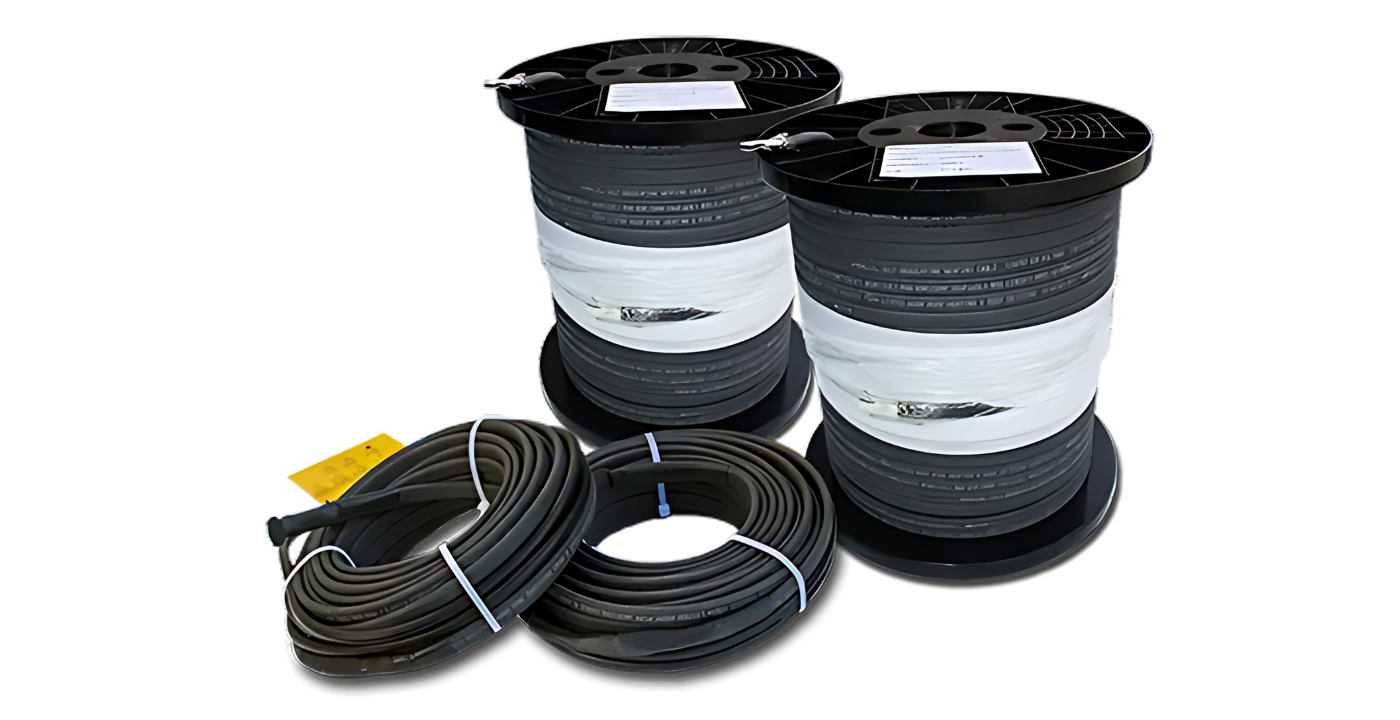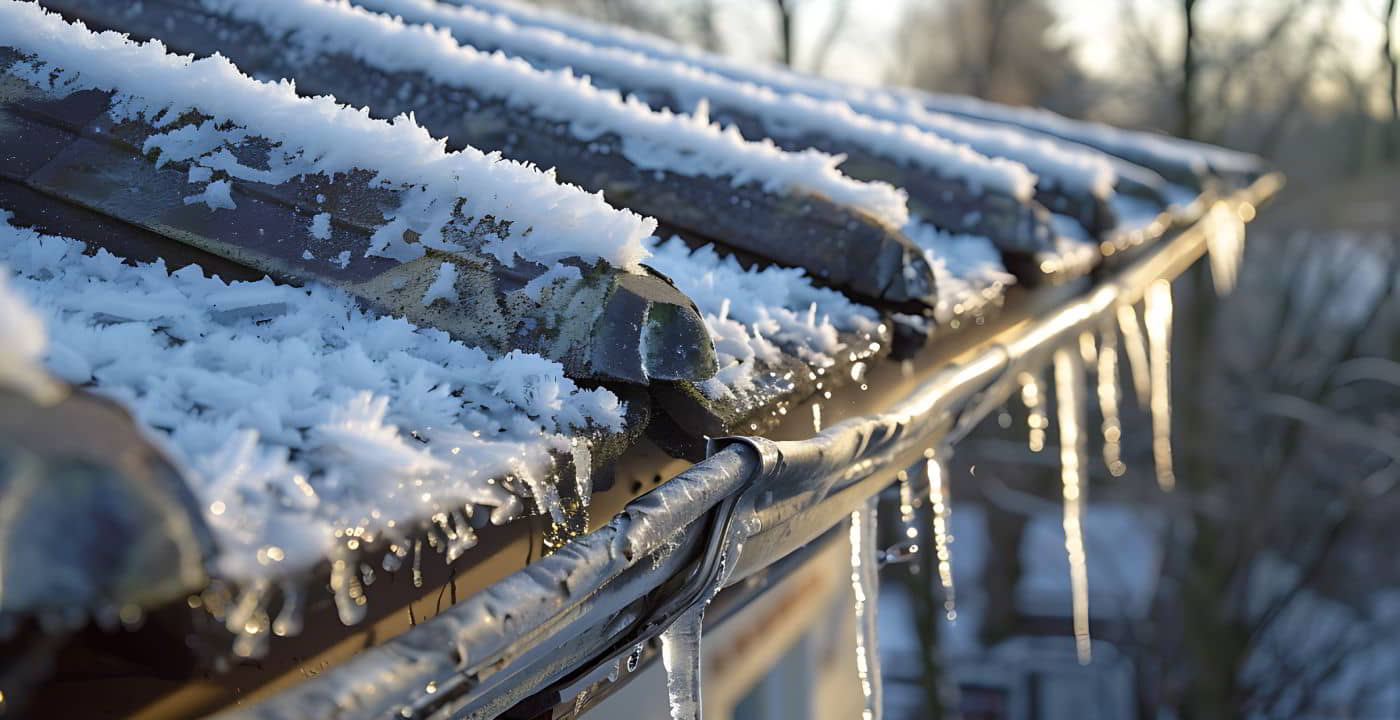If you’re looking for a convenient deicing solution for your roof then you’ve probably considered heat tape. But does this convenience come at a high price?
As industry experts in roof heating solutions, our knowledge of heating cable installation and running prices is extensive. So we’ve compiled this handy guide to help you decide if it’s an affordable choice for your home.
We also break down the two main types of heat tape and delve into the reliability, cost and efficiency benefits they offer.
Ready to dive into all you need to know about heating cable installation and running prices? Read on
Key Notes
- The cost of heat tape varies between approximately $1 to $3 per linear foot for materials and between $5 to $15 per linear foot for professional installation.
- Heat tape typically consumes between 3 to 5 watts of power per linear foot per hour with monthly running costs ranging between $40 to $200.
- There are two main types of heat tape – self-regulating and constant wattage
- Proper installation is important to maximize efficiency and lifespan.
How Much Does Heat Tape Cost To Run?
According to Home Guide, heat tape typically consumes between 3 to 5 watts per foot, making its operational cost an important consideration in your overall energy consumption.
As an example, a 30-foot heat tape uses about 90 to 150 watts per hour. Based on average electricity rates, this translates to an operating cost of roughly $1 to $2 per month per 10 feet.
Bear in mind that monthly running costs can range from $40 to $200, depending on local electricity rates and usage patterns.
Heating Cable Installation Costs
The installation costs for roof heating cables range from $5 to $15 per linear foot, with total expenses typically falling between $500 and $2,000. Let’s break these costs down into the main components.
1. Materials

The biggest factor in your cost calculations is the type of heat tape you choose and you can expect to pay anything between $1 and $15 per linear foot. The two main categories are self-regulating cables and constant wattage. Let’s break down both of these.
Self-Regulating Heat Tape
These smart roof heating solutions adjust their power output based on ambient temperature, increasing heat output when it’s cold and decreasing when it’s warm. This reduces your long-term operating costs, resulting in significant savings on your electricity bills, especially in varying climates.
For this reason, self-regulating heat tape is a popular choice for energy-conscious households wanting to cut down on energy wastage.
Here are some other advantages of self-regulated heat tape:
- Safety: Self-regulating heat tape reduces the risk of overheating and fire hazards because it automatically decreases its power output as temperatures rise. This makes it safer for long-term use compared to constant-wattage cables.
- Ease of Installation: These cables can be cut to length during installation, simplifying the process and potentially reducing labor costs. They are also easier to install on complex roof structures.
- Durability: Self-regulating cables tend to have a longer lifespan due to their ability to prevent overheating. This durability translates into fewer replacements and lower long-term maintenance expenses.
Constant Wattage Heat Tape
As its name suggests, constant wattage heat tape provides a consistent level of heat, regardless of the weather and ambient temperature.
Although cheaper these non-regulating products can cost you in the long run as they tend to be less energy efficient and can lead to higher electricity bills.
2. Labor
If you’re using a professional installer you can expect to pay between $50 to $200 per hour for fitting. For an average-sized roof between 150 and 300 linear feet, installation can take between 4 and 8 hours.
Bear in mind that this price can change according to the complexity and length of your installation and that labor prices fluctuate seasonally and increase when demand is high.
Accessibility is another aspect to consider. If your roof is steep, you have multiple stories or lack internal access, your labor quotation may be higher.
Labor costs for professional heat tape installation are usually cheaper in summer when demand is low.
3. Roof Type and Size
The complexity and size of your roof will have a significant effect on your installation costs. Larger roofs with multiple angles or those with dormers, valleys, and longer eaves need more cable, making them more expensive than simple roofs.
Also consider the placement of your cables, as most heat cables are attached in a zig-zag pattern. This melts more snow but also increases your material needs.
4. Additional Components
Some homeowners choose to automate their heat tape systems with temperature sensors and other control mechanisms. While more convenient, it adds to your overall cost.
For instance, an automatic cable control thermostat sets you back between $40 to $120, however it can save electricity when added to a manual roof heat cable.
| Additional Components | Cost |
|---|---|
| Automatic Cable Control Thermosta | $40 - $120 |
| Clips, Fasteners, Electric Tape | $10 - $50 |
| Outdoor-Rated Extension Cord | $20 - $100 |
| Ladders | $50 - $300 |
5. Peripherals and Extras
Besides heat tape, you’ll need a few extra components before you’re ready for installation, especially if it’s a DIY job. Here are the main points to consider.
- Equipment and consumables – such as an automatic thermostat or a manual controller
- Clips, fasteners and electric tape – to securely install your heat tape
- Outdoor-rated extension cord – to provide electricity to power tools
- Ladders – for easy access to your roof
Here’s a comprehensive breakdown of overall heat tape installation costs:
| Roof Size | Labor Estimate | Self-Regulating Material Cost | Constant Wattage Material Cost | Total Cost Self-Regulating | Total Cost Constant Wattage |
|---|---|---|---|---|---|
| 100' (16"-18" Overhang) | $30 - $87.50 | $500 - $1,500 | $120 - $370 | $530 - $1,587.50 | $150 - $457.50 |
| 100' (36"-42" Overhang) | $60 - $175 | $550 - $1,600 | $120 - $370 | $610 - $1,775 | $180 - $545 |
| 150' (16"-18" Overhang) | $45 - $131.25 | $750 - $2,300 | $155 - $455 | $795 - $2,431.25 | $200 - $586.25 |
| 150' (36"-42" Overhang) | $90 - $262.50 | $800 - $2,350 | $155 - $455 | $890 - $2,612.5 | $245 - $717.5 |
| 200' (16"-18" Overhang) | $60 - $175 | $1,000 - $3,000 | $190 - $540 | $1,060 - $3,175 | $250 - $715 |
| 200' (36"-42" Overhang) | $120 - $350 | $1,100 - $3,100 | $190 - $540 | $1,300 - $3,450 | $310 - $890 |
Use this handy roof heat tape calculator to quickly determine how much heat tape you need for your roof.
Heat Tape Cost Calculator
Keeping Your Roof Heating System Energy-Efficient

If you’re concerned about how much heat tape costs to run here are a few tips to keep expenses down.
- Use a timer to run the heat tape only when needed. This minimises power wastage and improves your household’s energy efficiency.
- Run the heat tape during the day when the sun is out and the snow is melting. This lets you cut down on operation at night, which is usually more energy-intensive.
- Install a heat tape system with a manual toggle switch, so you can easily turn the tape on and off as needed.
The Benefits of Heat Tape For Your Home
Using heat tape in homes and buildings has several advantages. Here’s a quick look at its most significant ones.
- Prevention of Ice Dams: Ice dams can cause significant roof damage and water leakage. Heat tape prevents this by ensuring that melting snow drains properly.
- Maintains Proper Drainage: By keeping gutters and downspouts free of ice, heat tape allows for uninterrupted water flow.
- Reduces Maintenance Needs: Regular use of heat tape cuts down on frequent roof repairs or gutter maintenance.
Get ready for winter
Self-regulating heat tape minimises power wastage, making it an environmentally friendly choice
Tips to Keep Your Heat Tape in Tip Top Shape
To keep your heat tape running optimally and reduce the chance of costly repairs, it’s important to carry out regular maintenance. Some key maintenance practices include:
- Periodic inspections to regularly check the tape for signs of wear or damage.
- Test your heat tape before cold weather arrives to check if it’s working correctly.
- Keep the area around your heat tape clean to prevent debris from interfering with its operation.
Professional Installation or DIY?
Go With The Pros
Proper installation is crucial to ensure efficiency and maximize the lifespan of heat tape. Professional installation ensures the tape is correctly placed and connected, reducing the risk of overheating or underperformance.
The Danger of DIY
Although some people choose to install their own heat tape, common DIY mistakes include incorrect placement and inadequate insulation, leading to increased energy consumption and reduced effectiveness.
Choose A Convenient Heat Tape Kit
You can also opt for quick and convenient installation with a roof heat tape kit including a pre-assembled factory power connection, splice and end seal. This helps to streamline DIY or professional installations as there’s less need for special tools or skills.
By removing the hassle of time-consuming and error-prone on-site assembly, you reduce the risk of human mistakes for improved safety while maintaining high quality and reliability. In addition, there’s no need to buy heat shrink guns or crimping tools.
FAQs
1. How long does heat tape usually last?
Heat tape typically lasts three to five years, depending on factors such as the quality of the tape and how well it’s installed. Manufacturers usually provide a 1-year warranty.
2. How often should I replace my heat tape?
Consider replacing your heat tape every few years, especially in cold climates.
3. Does heat tape use a lot of electricity?
The energy consumption of heat tape depends on several factors including the tape itself, its power rating and the duration of operation.
4. Can I integrate a heat tape system with a building's automation controls?
Yes for commercial buildings, consider integrating the heat tape system with the building’s automation controls to optimize energy consumption by only running the tape when the air temperature is above 32°F (0°C) and the sun is out.
Ready For a Customised Quote?
Now that you’ve got a good grip on the installation costs of heat tape, you’re ready to make an informed choice. Contact us today for a free quote and we’ll send you a custom system design that’s just right for your home.






